Well, first, it wasn’t exactly head cheese, per se; it was porchetta di testa — a fully boned out pig’s head that is marinated, seasoned, rolled, tied, cooked very slowly (like 14 hours slowly) and then thinly sliced — purchased from our friends at The Meat Market in Great Barrington, Masschusetts during the late afternoon hours of October 28th. (If you’re interested in the hows and whys of porchetta di testa, watch Chris Cosentino here; WARNING, though….the video and process are not for the faint of heart but if you believe, as I do, that utilizing absolutely every part of the animal is not only fiscally sensible but also morally, ethically right and as Fergus Henderson says, the polite thing to do, you get over it fairly quickly.) It was this porchetta di testa that was sitting in our refrigerator when the lights flickered a few times and then went off. For six days.
We had it easy when Sandy arrived. We knew she was coming, so we filled up our bathtub and every large vessel (our 24 quart stock pots came in handy here) with water to use for flushing and dish-washing. We filled both cars with gas. We brought in our remaining few logs from the first and only cord of wood we’ve ever had delivered since moving in nine years ago (our fireplace is in a wonky location and isn’t particularly efficient) and bought a few yuppie bundles just in case. We bought three twenty pound bags of ice and parceled them between four coolers. We replenished our supply of canned goods and candles. We’d just received our bi-annual propane top-off, so the 99 gallon tank that fires our Viking (the cooktop, not the oven, which is electric) was full. I sent a huge shipment of canned goods and water to my mother in upper Manhattan. So we were ready.
But when Sandy hit, she hit hard. Comparatively, we were safe: we didn’t lose our home or our cars or our animals or our honeybees or our lives. Fire didn’t destroy my neighborhood the way it did Breezy Point, where my late uncle Leo lived for sixty years. It didn’t demolish the homes and businesses of thousands the way it did in New Jersey, Rockaway, downtown Manhattan, or Brooklyn. It didn’t leave us homeless and heartbroken, a sliver of a fraction of scores of people walking around in a daze, waiting for help from the Red Cross and FEMA, and more immediately served by the grassroots volunteer effort that people from all over the New York area organized almost instantly.
It moves me to tears; I love my city, and the people in it. The storm touched every place in the New York area I have a connection to: Manhattan, where I was born and lived for so many years. Queens, where I grew up, and swam in the waters off Rockaway two decades before a hip taco stand and soft waves turned it into a surfer haven. Brooklyn, where my mother was born and raised in Williamsburg; where her parents were born at the turn of the century; where my father grew up and landed his Grumman Hellcat at Floyd Bennett Field on leave from the Navy during World War II; where I lived for almost two years in what had been my grandmother’s apartment near Coney Island, where the walls reeked of the schmaltz of a thousand shabbos dinners, and where Neptune Avenue and the high-rise buildings near it — mostly home to stranded elderly residents — are still shrouded in darkness.
In southwestern Connecticut, where I live now, what we faced was more annoying than anything else: for a few days, live wires dangled around our neighborhood streets, stranding us at home on the western side of my town with no sign of utility crews. Initially, our response to the storm was to hunker down with cookbooks and read them all day when we had benefit of light, compiling lists of dishes we’d plan to make when the power came back on (or at least when we could cook in the oven instead of just on top). New and old, we piled them up between us as we sat on the couch under the picture window: there was Canal House Cooks Everyday, which has already wrapped itself around me like a security blanket. Dorie Greenspan‘s Baking from My Home to Yours; Marion Cunningham’s The Breakfast Book; Deb Perelman’s The Smitten Kitchen Cookbook; Katie Quinn Davies‘ What Katie Ate; Caroline Fidanza’s Saltie; Yotam Ottolenghi and Sami Tamimi’s Jerusalem. And before we knew it, the light had faded and, wanting to save battery and candle power, we stopped reading. Our list, heavy with recipes culled from books that have one thing in common — comfort — held the promise of dinner parties small and big and quiet lunches of beans on toast. It was very lovely and cozy.
And then we ran out of firewood and batteries.
I started making inappropriate Donner Party jokes.
I rifled through the fast-warming fridge, rescuing the porchetta di testa, a tub of melting demi glace, a single smoked ham shank that I’d purchased at the Allentown Farmer’s Market the last time I was in Pennsylvania, and a dozen eggs from the chicken girls who live next door. Susan did the only thing she could do — the only thing that seemed right, and normal, in a time of dire circumstance: she made crumpets.
There are plenty of other pan-breads that you can cook on top of the stove when the electricity goes out. There’s naan. Pita. Chapati. Roti. Saj. Pancakes. But no: Susan had to make crumpets. Because when we lose power and that immediate tinge of excitement is replaced with fear and what-ifs, my spouse goes English. Every time. It may have something to do with her childhood, and finding tranquility in Squirrel Nutkin and Moldy Warp. Who knows. While our neighbors and friends around us cooked up vast, mouthwatering batches of macaroni and cheese and grilled hot dogs and hamburgers on their propane-powered grills while the rains fell and the trees snapped, we ate crumpets. Topped with the porchetta di testa.
When that was gone, we sifted through the pantry and pulled out a bag of Lentils du Puy, and made a sort of bastardized version of Petit Sale with the pork shank. Ever since having this dish one day with friends at Bistro Jeanty in Yountvillle California, I’ve tried to recreate it, with little luck: meaty and thick and velvety under a blanket of buttery demiglace, it made every person sitting at the table swoon, including two former vegetarians of some visibility. Puttering around the house waiting for the graying light to fade, I made a batch of French lentils from a recipe that may have originated long ago with Dorothy Kalins back in her Metropolitan Home days, settled the shank down into the simmering pulses until it was warmed through, pulled the meat off the bone, and folded it back into the pot along with a hefty tablespoon of the demiglace. We ate it for days by itself, and then, topped with poached eggs, sopping up the runny yolk with what was left of Susan’s crumpets.
Six days after the storm touched down on the east coast, the wires were cleaned up, and our power returned. We’d gotten away easy: watching images on the news of elderly, homebound folks stranded up on the high floors of apartment buildings in Brooklyn, I thought of my grandmother, and my mother, and I shuddered.
We were safe in the country, I decided. And ten days later, in the middle of a sunny afternoon, a neighbor of ours — the matter-of-fact, Yankee-to-the-core one who always hosts the storm parties in her gorgeous, rambling mid-1800s farmhouse — had a fire while her children were in school and she was waiting for her husband to get out of minor surgery at a nearby hospital, and lost the entire second floor of her home. As I once said here, Mentsch tracht, gott lacht.
Thanksgiving is next week; we’re looking forward to huddling with our godbaby and cousins down in Virginia, and their lifelong friends from Arkansas, and just being together and holding each other close, whatever the weather may bring.
Crumpets
(From The Breakfast Book by Marion Cunningham)
Luscious, crispy on the outside, tender on the inside, and always best eaten warm.
Makes one dozen crumpets
1 package yeast
1/4 cup warm water
1 teaspoon sugar
1-1/2 cups milk, warmed
2 cups all-purpose flour
1 teaspoon salt
1/2 teaspoon baking soda
1/4 cup warm water
Sprinkle the yeast over the warm water in a mixing bowl. Add the sugar, stir, and let the yeast dissolve for 5 minutes. Add the milk, flour, and salt. Beat until smooth. Cover the bowl with plastic wrap and let stand for 1 hour. Stir down, dissolve the baking soda in 1/4 cup warm water, and stir into the batter. Cover and let rest for 30 minutes.
Heat a griddle and grease some 3-inch rings. When the griddle is medium hot, grease it and place the rings on it. Spoon about 3 tablespoons batter into each ring, just enough to cover the bottom. Lower the heat and cook slowly for about 8 minutes, or until the tops of the crumpets have lost their shine and are dull and holey. Remove the rings and set aside the crumpets. When you’ve finished the batch, toast the crumpets, butter them generously, and serve.
(Assuming you have electricity, they freeze well double-wrapped in plastic and stored in freezer bags.)
Abbreviated Petit Sale
Essentially French pork and beans, real petit sale takes four to five days to prepare, but it’s absolutely worth it, especially if you make David Tanis‘s wonderful recipe (which appears in his great book, Heart of the Artichoke.) The dish I made during the storm is seriously truncated; I swapped out the cured pork for a smoked pork shank, let it warm through while the lentils swam around it, and the result was delicious (and even better the next day).
Serves 6-8 (or 2 with a lot of leftovers)
2 tablespoons extra virgin olive oil
1/2 cup pancetta, diced in 1/4 inch cubes
1/2 cup minced shallot
1/2 cup peeled and diced carrot
1/2 cup diced celery
1 cup dry red wine
2 cups Lentils du Puy
6 cups chicken stock
2 tablespoons fresh thyme leaves
1 1-1/2 pound smoked pork shank
1-2 tablespoons prepared veal demi-glace
1/2 cup chopped tomatoes
1 teaspoon unsalted butter
salt and freshly ground black pepper, to taste
In a large Dutch oven set over a medium flame, warm the olive oil until it begins to ripple, add the pancetta to the pot and cook until it just begins to release its fat. Add the shallot, carrot, and celery and continue to cook until translucent, about five to seven minutes. Pour in the red wine and reduce heat to medium low; simmer until the wine has completely evaporated.
Add the lentils to the pot along with the stock and the thyme. Nestle the pork shank in among the vegetables and lentils and simmer for fifteen minutes; remove the shank and set aside until cook enough to handle. Continue to cook the lentils for another twenty minutes or until tender. While they’re cooking slice the pork off the bone, and fold it back into the lentils, stirring well (but gently) with a large spoon to combine.
When the lentils are tender, fold in the demi-glace and the tomatoes, and continue to cook over very low heat, until everything is tender and smokey. Stir in the butter, and season to taste. Serve warm or at room temperature.

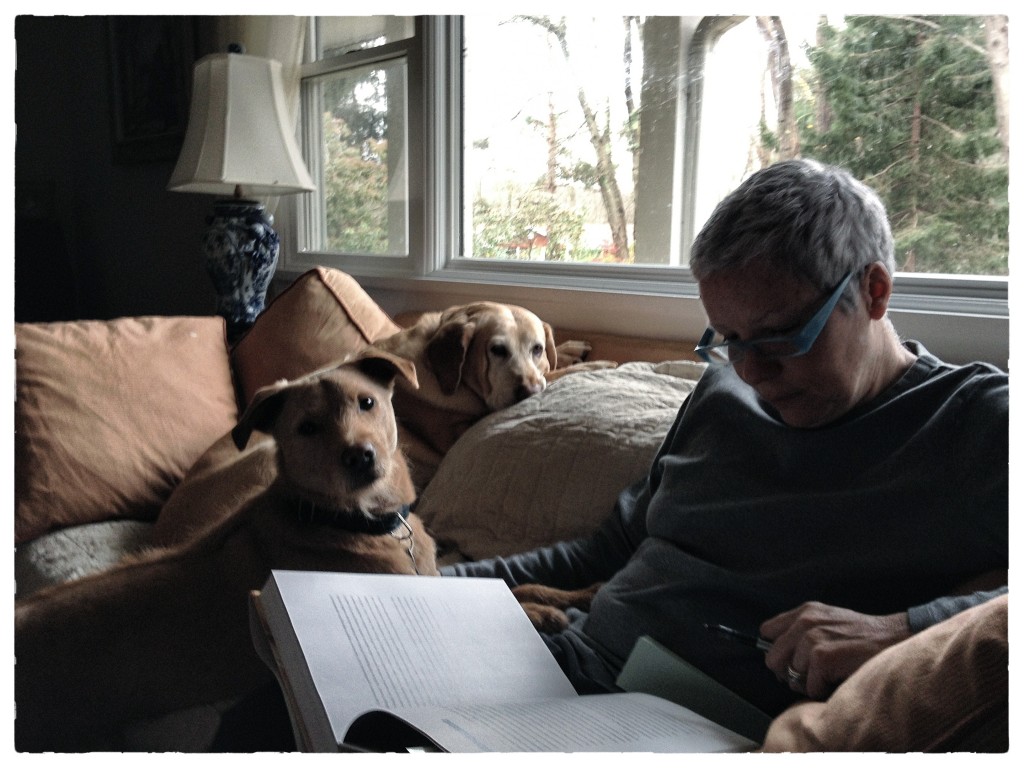
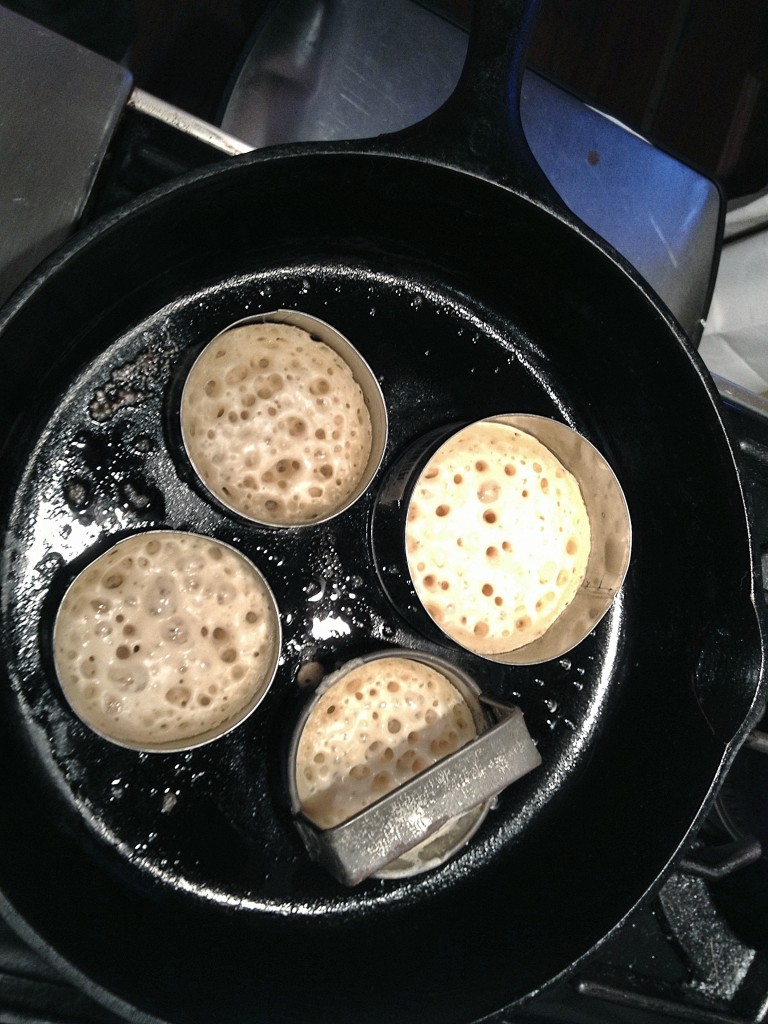
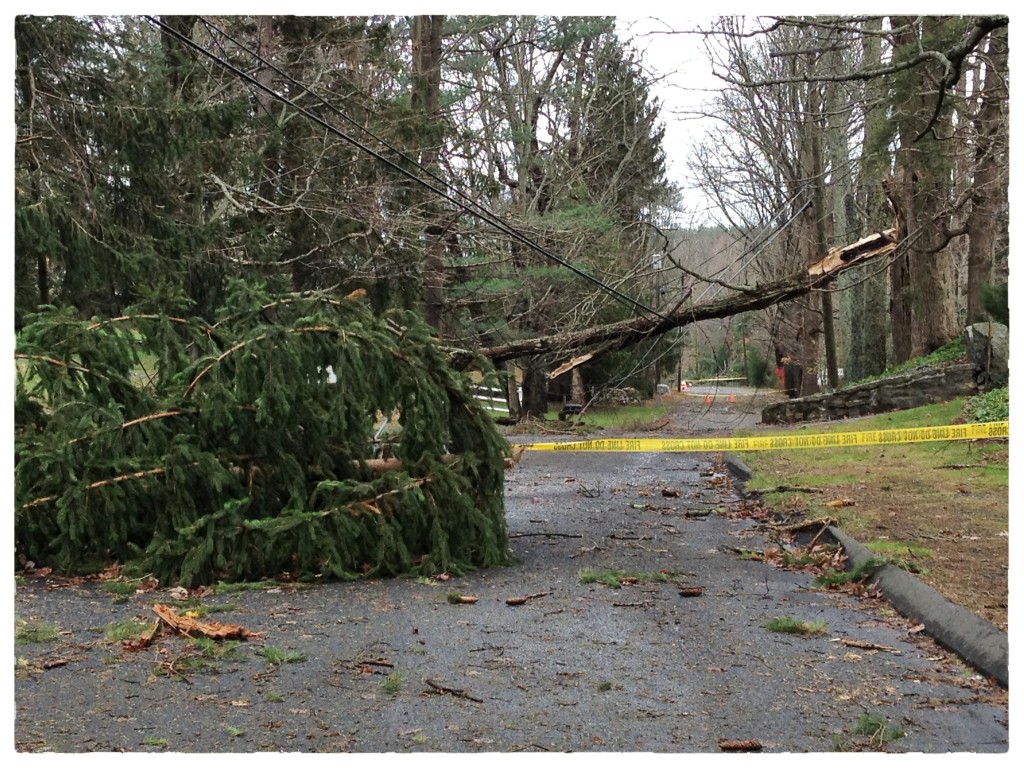
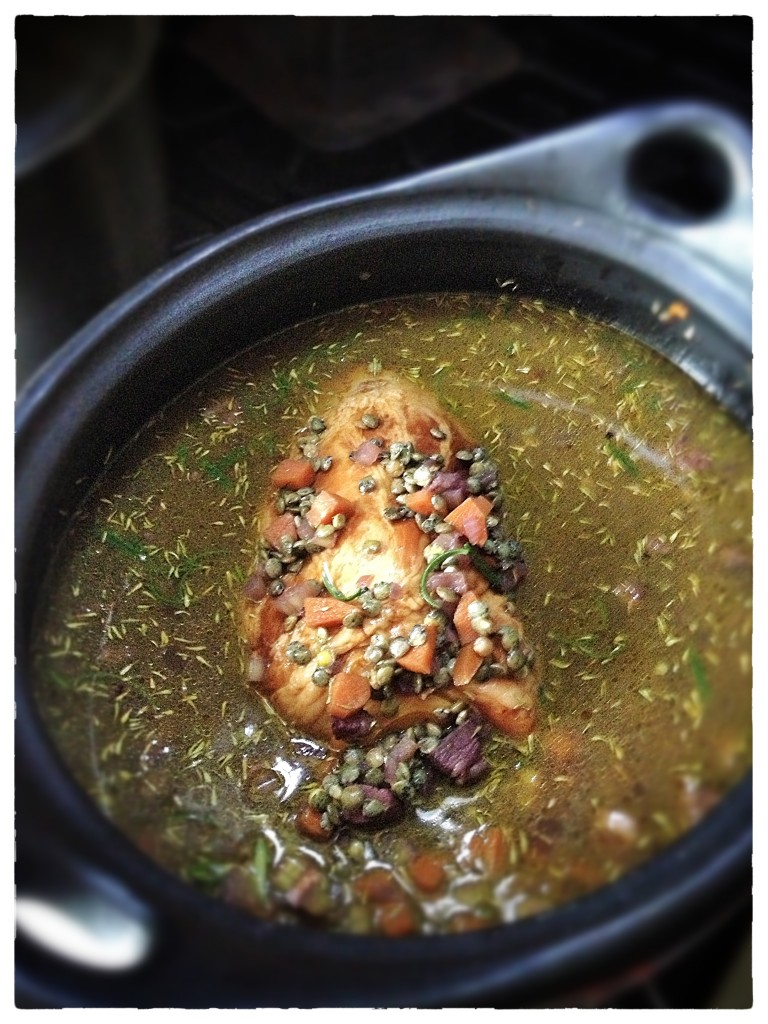
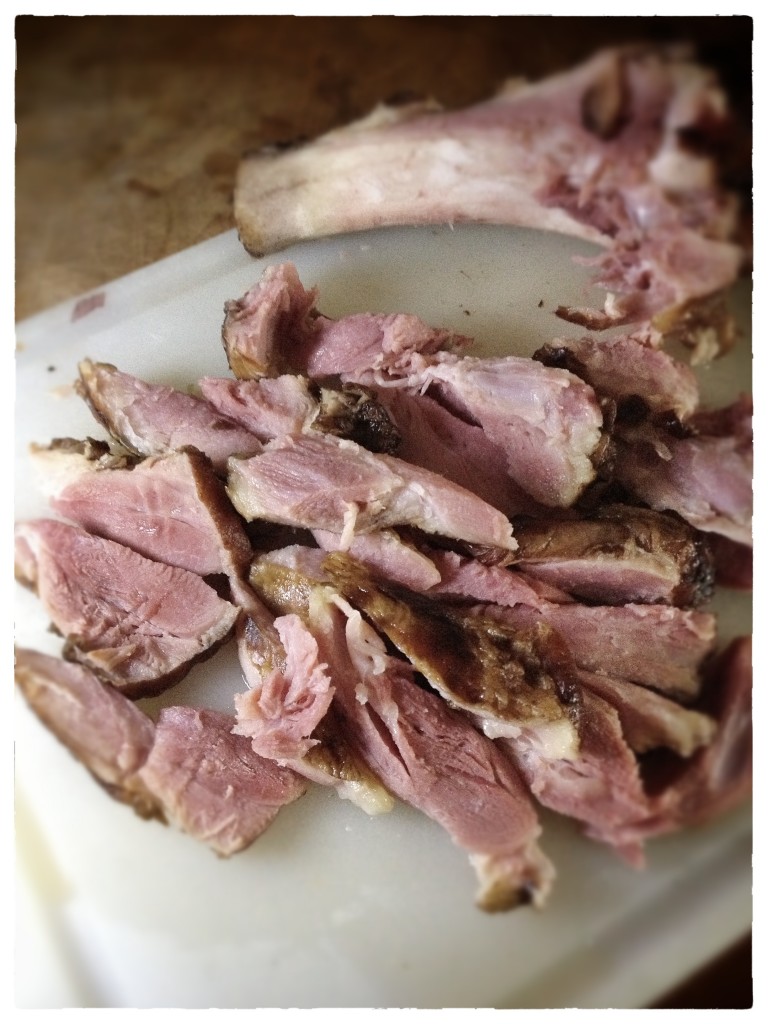
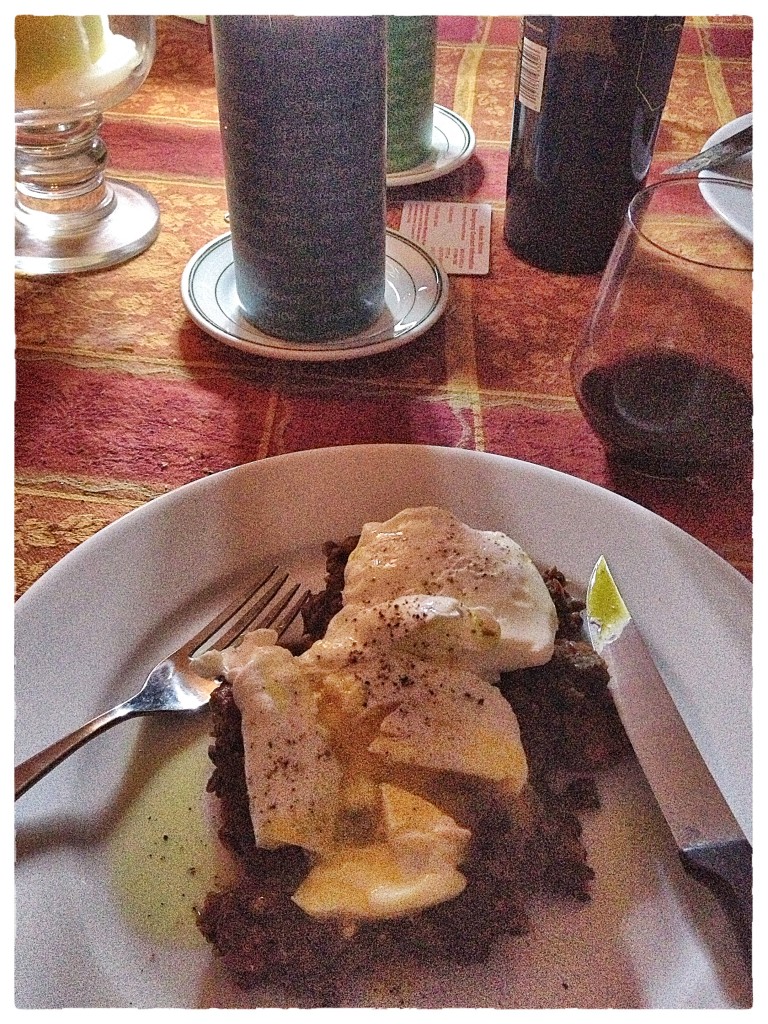




Oh, indeed. To all of that, from the tremendous testa down to your cozy, crumpety toes.
Lovely.
Honeybees???
That crumpet recipe is beloved here, and when next we make it I will think of you and Susan making them stove-top, keeping warm and staying safe. For the rest … oh this world. I continue to hold a good thought for everyone that Sandy assaulted to be warm and safe and well-fed as Thanksgiving arrives and we head full-steam into holiday season. Here’s wishing some Petit Sale, or at least pork and beans, for all.
Thanks Hannah—
I love the porchetta di testa food contrast with your Forks Over Knives experiment back in the Fall. Your blog is never one-note, which is one of the many reasons it’s so very good. Speaking of which, when-oh-when is that Prevention article due to be published? I love hearing the results of self-experimentation with diet & health.
Thanks so much Ellen—stay tuned! I should have a date fairly soon!
Crumpet recipe. Just what I needed. Thank you. (I grew up with non-yeast crumpets served with golden syrup and whipped cream.)
Are the rings necessary because the butter is very runny, hence bubbly?
I’d better cook dinner. You’ve made me very hungry.
we got hit fairly hard too (cape cod), not as hard as your area.
every new storm/hurricane/and now I can say earthquake we get I wait for the tree(s) to fall on the house.
as soon as we get out tax money back we are chopping down trees that are closest to the house; this should help my nerves (a bit).
head cheese: as a child, my grandfather would only eat head cheese on the boat; it was not allowed in his home. lol
and as a child I always thought it was made from human heads. (kind of smells like it is right?)
happy thanksgiving to you & your family–enjoy